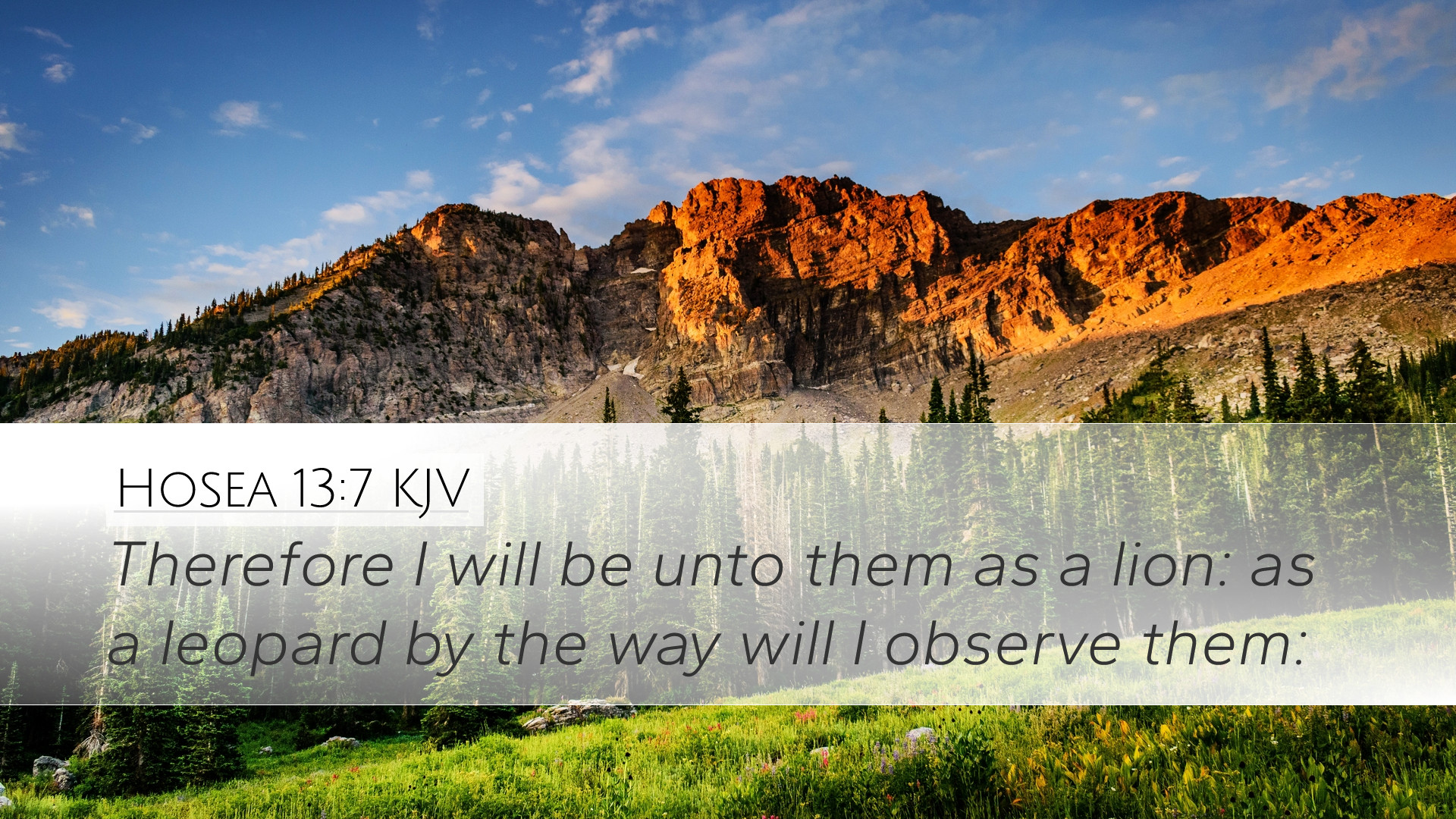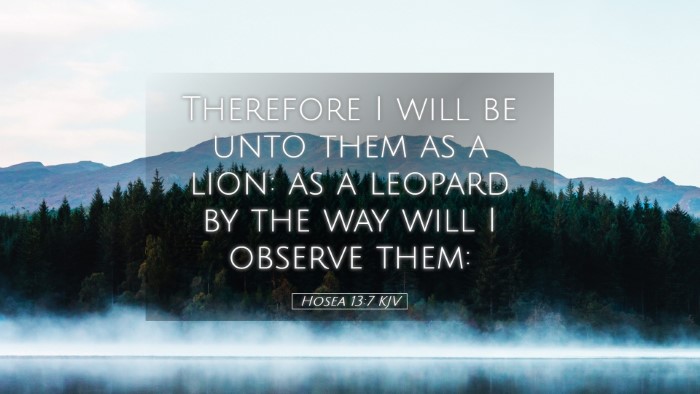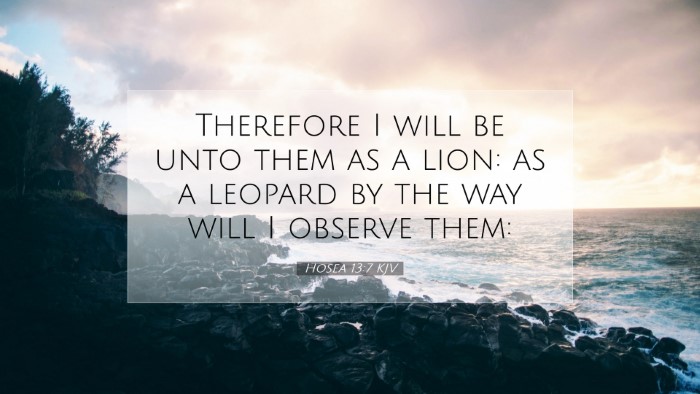Old Testament
Genesis Exodus Leviticus Numbers Deuteronomy Joshua Judges Ruth 1 Samuel 2 Samuel 1 Kings 2 Kings 1 Chronicles 2 Chronicles Ezra Nehemiah Esther Job Psalms Proverbs Ecclesiastes Song of Solomon Isaiah Jeremiah Lamentations Ezekiel Daniel Hosea Joel Amos Obadiah Jonah Micah Nahum Habakkuk Zephaniah Haggai Zechariah MalachiHosea 13:7
Hosea 13:7 KJV
Therefore I will be unto them as a lion: as a leopard by the way will I observe them:
Hosea 13:7 Bible Commentary
Commentary on Hosea 13:7
Bible Verse: Hosea 13:7 - "So I will be to them like a lion; like a leopard I will lurk by the way."
This verse encapsulates a powerful image of God’s impending judgment and the means He will employ to Pize it. The use of fierce animals as metaphors conveys a sense of both strength and the inevitability of divine intervention. The following commentary combines insights from notable theologians Matthew Henry, Albert Barnes, and Adam Clarke, providing a comprehensive understanding of this pivotal scripture.
Exegesis of the Text
At its core, Hosea 13:7 reveals God's character as both a protector and a punisher. The juxtaposition of a lion and a leopard creates a vivid picture of stealth and ferocity, which emphasizes the seriousness of the warning God gives to His people.
Matthew Henry's Insight
Matthew Henry emphasizes the metaphoric significance of the lion and leopard. He interprets these animals as symbols of God’s sovereign power and judgment. According to Henry, the lion represents the strength and majesty of God, invoking a reverence and fear that accompanies His wrath.
Henry notes that as a lion attacks its prey with ferocity, God will swiftly execute His judgment on Israel for their unfaithfulness. Furthermore, the mention of the leopard lurking by the way highlights God’s omnipresence and the unexpected nature of His impending judgments. Just as a leopard ambushes its prey, God's judgments may come at unexpected times, startling those who are unaware of their precarious spiritual condition.
Albert Barnes' Reflection
Albert Barnes provides a more pastoral angle in his analysis. He explains that the imagery serves as a representation of God's protective yet punitive role. Barnes cites that the leopard symbolizes the quickness and surprise of divine justice. He asserts that the unrepentant will not escape God's scrutiny, as He is ever watchful and ready to act against sin.
Moreover, Barnes emphasizes that God's judgment is not arbitrary; instead, it is a response to the constant rebellion and idolatry practiced by the Israelites. He encourages readers to reflect on the consistent themes of repentance and divine mercy throughout Hosea. Barnes insists that while the leopards' lurking brings an element of fear, it should also prompt reflection and a return to faithful worship.
Adam Clarke's Analysis
Adam Clarke delves into the historical context surrounding this verse. He highlights that Hosea’s prophetic ministry was directed towards Israel during a time of moral decay and rampant idolatry. Clarke connects the imagery of the lion and leopard to the Assyrian threat that loomed over Israel, suggesting that God employed these metaphors to illustrate the real and present danger posed by their enemies.
Clarke further argues that God’s fierce nature, as represented by these animals, reveals His unwillingness to tolerate unfaithfulness. He also points out that the lurking nature of the leopard signifies that God's judgments may be silent, yet they are certain to occur. The contrast between grace and judgment underlines Clarke's commentary, framing the divine promise of punishment against a backdrop of hope for eventual restoration if the people would turn back to Him.
Theological Implications
The imagery of God as a lion and leopard serves as a reminder of His dual nature as both a defender and a judge. This scripture highlights several important theological themes:
- The Justice of God: The fierce portrayal of God here provides a stark reminder of His justice. Sin does not go unpunished; divine consequences are inevitable.
- The Call to Repentance: This verse serves as a clarion call for repentance. For contemporary readers, it encourages a spirit of humility before God, recognizing the need for continual return to Him amidst personal and corporate sin.
- The Sovereignty of God: God's ability to act swiftly and decisively is a testament to His sovereignty. In the challenges and judgments we face today, believers are reminded that God remains in control and is aware of our plight.
Application for Today
This prophetic message is just as relevant for today’s believers as it was for Israel. The imagery of divine judgment can serve as a sobering reminder of the consequences of straying from faithfulness. Pastors and teachers can draw upon this text to emphasize the need for vigilance against the cultural and moral distractions that threaten spiritual integrity:
- Encouragement for Vigilance: Just like a leopard lurks, believers are called to remain alert and aware of spiritual dangers surrounding them.
- Importance of Accountability: In community, believers are encouraged to hold one another accountable to live faithfully before God.
- Hope in Restoration: The passage ultimately calls for trust in God’s ability to restore—it is not merely about judgment but also about hope for redemption and renewal.
Conclusion
Hosea 13:7 richly illustrates the complexity of God’s relationship with His people, balancing justice with compassion. The collective insights from Matthew Henry, Albert Barnes, and Adam Clarke remind readers of the implications of divine judgment while encouraging a response of repentance and faithfulness. In viewing God as both lion and leopard, we comprehend the profound depth of His character and His active engagement with humanity. For pastors, students, theologians, and scholars alike, this verse invites further exploration of God's principles and attributes as we navigate our faith journey in a world that oftentimes mirrors the chaos of ancient Israel.


